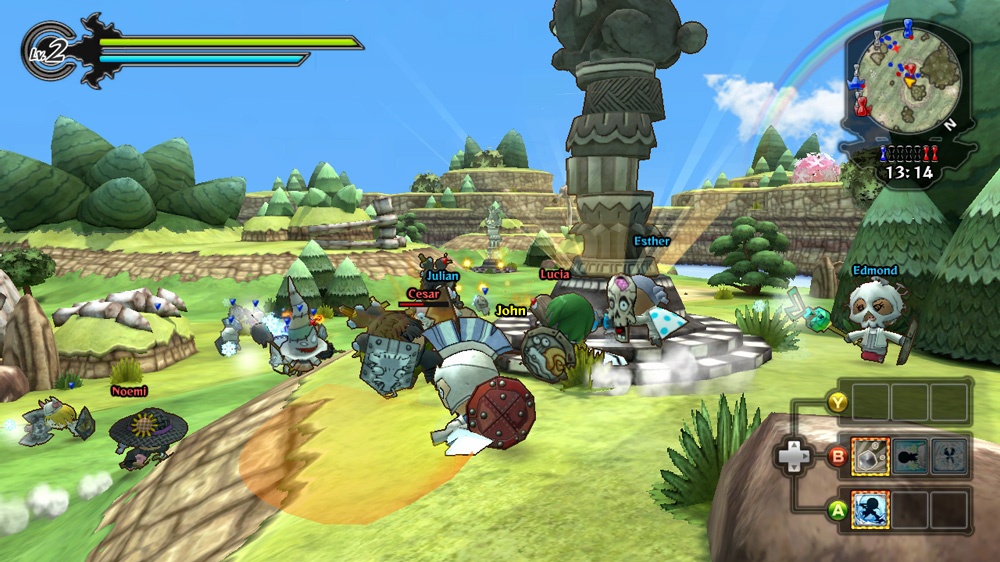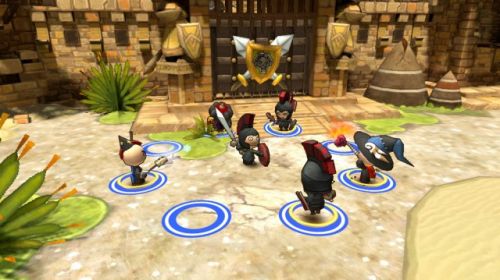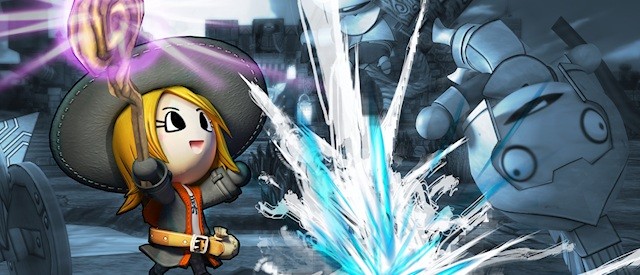Happy Wars, from Japanese developer Toylogic and Microsoft Studios is the first free-to-play (AKA freemium) Xbox Live Arcade game. The title is offered for free to Xbox Live Gold members and monetized by the sale of optional premium items. As the flagship for a new and increasingly popular business model, Happy Wars needs to both be enjoyable for players who buy nothing while enticing dedicated players to spend some coin. Happy Wars does both things very well, though this review is more concerned with the divide between co-op and versus multiplayer.
At first glance, Happy Wars looks like the Xbox 360’s answer to Fat Princess on the Playstation 3. Both games involve two large teams of online players to compete against each other in a cartoonish action setting. But Happy Wars differs most significantly in the vast array of character customization and equipment that it offers. You can personalize each of your three classes’ hair, face, and skin color, and then deck them out with a huge arsenal of weapons and armor, so that very few advanced characters will look alike.
Players can choose from all three classes at the start of a game and whenever they respawn, so they’re never tied down to a single character. Each one has varying offensive potential as well as several unique skills (8 individual skills and 3 team skills) that the other classes can’t use. The decision of which character to use comes down to playing style as well as the needs of a particular game. If one class is underrepresented on a team, you might want to switch to it in order to round things out.

The ones with red names are the bad guys.
The Fighter is the standard warrior class, utilizing melee weapons and shields during combat. He (or she, any class can be either gender) can’t heal, so he’ll rely on other classes for support. But his special skills give him devastating close-range attack abilities. Smash can knock enemies off of ledges and to their deaths; Stone throw stuns enemies hit from behind; Rocket Man launches the Fighter at enemies like a torpedo, and so on. Fighter is fun to play as long as you’ve got a Cleric nearby to patch up your wounds.
Cleric acts as the support class, specializing in both healing and tactical skills. He still holds his own in a fight though, especially against Mages. The Cleric can heal individual teammates, cast the super useful area-of-effect healing Sanctuary spell, and Resurrect fallen comrades instantly so they don’t have to wait for a respawn timer. I wish Resurrect could be hotkeyed separately from Heal or Sanctuary, but instead you have to switch back and forth between them, lessening the likelihood that players will revive each other at a moment’s notice. The Cleric can also build tactical machines faster and use them more effectively than other classes. (These include battering rams for knocking down castle gates, ladders for scaling walls, cannons, and more.)
Mages can’t wear as much armor as the other classes, and yet their magical attacks make them somewhat overpowered. They can shoot projectiles at any time or cast devastating area-of-effect attack spells like Lightning Strike, potentially killing multiple opponents at once. Opponents will usually single out Mages for immediate disposal since they do so much damage and go down so easily, but they’re still killer at a distance.

Can I get a hell yeah?
In addition to individual skills, each class has its own team skills. To initiate one, press Y, which creates a number of glowing circles around you. Other players can join in by standing in a circle and pressing Y in kind. Most team skills require at least three participants, though they’re more effective (and provide everyone with a greater EXP bonus) with more teammates. Team skill effects include offensive attacks like Meteor Storm and Lightning Arrows, as well as stat-boosting Sacred Song and even Transport, which launches the group to the tower of the caster’s choice. My favorite is the Cleric’s Happy Miracle; it turns nearby enemies into helpless flowers. These skills encourage teams to stay close to each other and cooperate, always a good thing.
Battles take place on six expansive maps, with four more apparently planned for the future. Each side has its own castle with a tower inside. If the one team manages to get into their opponent’s castle (either via breaking the gate down or scaling the walls with ladders) and destroy their tower, that team wins. Along the way, teams can build (and contest) smaller towers that act as respawn points. The more people building or tearing down a tower, the faster the work goes – a great cooperative mechanic. Whichever team controls the most towers, especially the one closest to their enemy’s base, usually wins; but sometimes one side sneaks around and breaks into the other castle even without a respawn tower to its name.
